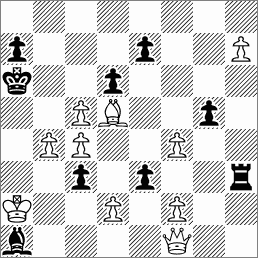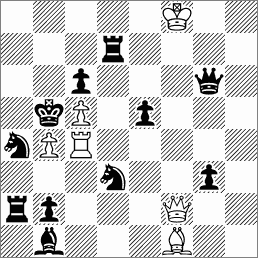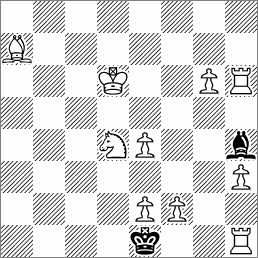Михаил Владимирович Тронов (17-11-1892 - 07-12-1978) Russian composer (Mikhail Vladimirovich Tronov)
Mikhail Tronov was a climatologist and composed direct mates in the Bohemian style.
Тронов, Михаил Владимирович
Шахматы 1926
3
rd Prize

Show Solution1.Qf1-d3 ! (2.Qd3-e4 [3.Bd5-b7#] 2...d6xc5 3.Qe4-e6#)
1...Rh3-h6/Rh3xh7 2.c5xd6 ~ 3.c4-c5#
1...d6xc5 2.Qd3-g6+ e7-e6 3.Qg6xe6#
1...e7-e5 2.Qd3-c2 (3.Qc2-a4#) 2...d6xc5 3.Qc2-g6#
1...e7-e6 2.Bd5-a8 (3.Qd3xd6#) 2...d6-d5 3.c4xd5#
A fine set of mates.
Enguelberto Berlingozzo (17-11-1905) Brazilian composer
Enghelberto Berlingozzo composed mostly helpmates, but also direct mates or selfmates, some of his problems in collaboration with Felix Sonnenfeld.
Berlingozzo, Enguelberto & Sonnenfeld, Felix Alexander
Memorial J. Figueiredo, 1980
1
st Prize

Show Solution1.Sd3-e1 Qf2-f5 2.Se1-c2 Rc4-d4#
1.Sd3-f4 Qf2-c2 2.Sf4-d5 Rc4-e4#
1.Sd3xc5 Qf2-d4 2.Sc5-e4 Rc4-c2#
In each solution the black Knight interferes with one of the black pieces Bb1, Qg6 or Rd5; one of these three pieces is interfered by the white Queen and finally the white Rook interferes with the last of these third pieces: cyclic interferences.
Николай Дмитриевич Надеждин (17-11-1938) Russian composer (Nikolay Dmitryevich Nadezhdin)
Nikolay Nadezhdin composes direct mates, mostly in two moves.
Надеждин, Николай Дмитриевич
E Heinonen-50 JT, 1974
2
nd Prize

Show Solution1.Sd4? (2.Be6#[B])
1...Bxd7[a] 2.c6#[D]
1...e4[c] 2.Qh5#[C]
1...exd4 2.Qe6#
but 1...c6[b]!
1.Qe3? (2.Se7#[A])
1...e4[c] 2.Qd4#
but 1...Bxd7[a]!
1.Qg4? (2.Se3#[E])
1...Bxd7[a] 2.Se7#[A]
but 1...e4[c]!
1.Kf6! (2.Qxe5#)
1...Bxd7[a] 2.Se7#[A]
1...c6[b] 2.Be6#[B]
1...e4[c] 2.Ne3#[E]
Dombrovskis.
Vladimir Janál (17-11-1964) Czech composer
Vladimir Janál is specialized in long problems, especially series movers, where the aim may be mate, stalemate or capture. He is thus the author of a world record minimal for series-helpstalemate stipulation:
sh=99 with a lone black King.
In the below problem two black units can move and the move order is logically determined:
Janál, Vladimír
Blog zlínského problemisty, 21
st Jun 2009

Show SolutionIn order to reach the final position with bKg4, Black must eliminate wPh3, therefore also wRh1, and wSd4. This is achieved in several steps and systematic manoeuvres:
- the bB reaches g1 to interfere with wRh1
1.Ke1-d2 2.Kd2-c3 3.Kc3-b4 4.Kb4-a5 5.Ka5-a6 6.Ka6-b7 7.Kb7-c8 8.Kc8-d8 9.Kd8-e8 10.Ke8-f8 11.Kf8-g7 12.Kg7-f6 13.Kf6-g5 14.Kg5-f4 15.Bh4-g3 16.Bg3-h2 17.Bh2-g1
- bK goes back to capture wRh1
18.Kf4-g5 19.Kg5-f6 20.Kf6-g7 21.Kg7-f8 22.Kf8-e8 23.Ke8-d8 24.Kd8-c8 25.Kc8-b7 26.Kb7-a6 27.Ka6-a5 28.Ka5-b4 29.Kb4-c3 30.Kc3-d2 31.Kd2-e1 32.Ke1-f1 33.Kf1-g2 34.Kg2xh1
- bK goes back again to allow the switchback of bB to h4
35.Kh1-g2 36.Kg2-f1 37.Kf1-e1 38.Ke1-d2 39.Kd2-c3 40.Kc3-b4 41.Kb4-a5 42.Ka5-a6 43.Ka6-b7 44.Kb7-c8 45.Kc8-d8 46.Kd8-e8 47.Ke8-f8 48.Kf8-g7 49.Kg7-f6 50.Kf6-g5 51.Kg5-f4 52.Bg1-h2 53.Bh2-g3 54.Bg3-h4
- bK goes back again to capture wPh3
55.Kf4-g5 56.Kg5-f6 57.Kf6-g7 58.Kg7-f8 59.Kf8-e8 60.Ke8-d8 61.Kd8-c8 62.Kc8-b7 63.Kb7-a6 64.Ka6-a5 65.Ka5-b4 66.Kb4-c3 67.Kc3-d2 68.Kd2-e1 69.Ke1-f1 70.Kf1-g2 71.Kg2xh3
- finally a few moves are needed to reach the stalemate position:
72.Kh3-g4 73.Bh4-f6 74.Bf6xd4 75.Bd4-e3 Ba7xe3 =




No comments:
Post a Comment